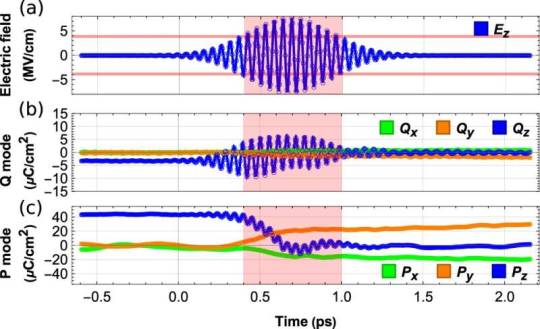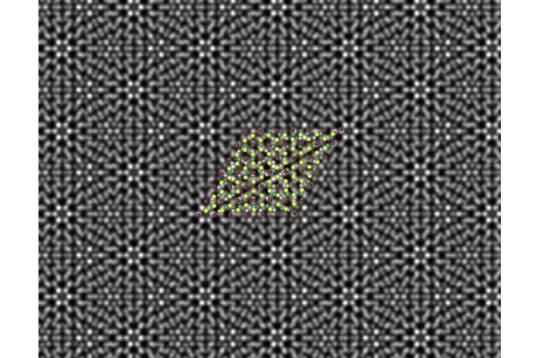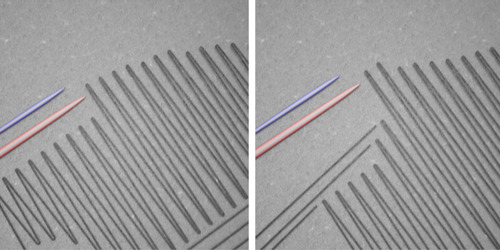Video
youtube
Magnetic Fields: Shape Memory Effect
24 notes
·
View notes
Photo

Physicists discover light-induced mechanism for controlling ferroelectric polarization
By applying light, University of Arkansas physicists Peng Chen and Laurent Bellaiche have discovered a surprising mechanism for controlling ferroelectric polarization in a deterministic manner.
The finding, made possible by the application of ultrafast laser pulses, enriches fundamental physics research by advancing an understanding of the interactions between light and matter.
The research, published May 10 in Nature Communications, is also an important step toward the design and development of superior sensing and data storage in electronic devices.
Ferroelectric materials exhibit ferroelectricity and the ability to polarize spontaneously. Typically, researchers can manipulate and reverse this polarization by the application of an external electric field. Ultrafast interactions between light and matter are another promising route for controlling ferroelectric polarization, but until now researchers have struggled to achieve a light-induced, deterministic control of such polarization.
Read more.
58 notes
·
View notes
Photo

Engineered crystals could help computers run on less power
Computers may be growing smaller and more powerful, but they require a great deal of energy to operate. The total amount of energy the U.S. dedicates to computing has risen dramatically over the last decade and is quickly approaching that of other major sectors, like transportation.
In a study published online this week the journal Nature, University of California, Berkeley, engineers describe a major breakthrough in the design of a component of transistors—the tiny electrical switches that form the building blocks of computers—that could significantly reduce their energy consumption without sacrificing speed, size or performance. The component, called the gate oxide, plays a key role in switching the transistor on and off.
“We have been able to show that our gate-oxide technology is better than commercially available transistors: What the trillion-dollar semiconductor industry can do today—we can essentially beat them,” said study senior author Sayeef Salahuddin, the TSMC Distinguished professor of Electrical Engineering and Computer Sciences at UC Berkeley.
Read more.
49 notes
·
View notes
Text
New transistors integrating high-k perovskite oxides and 2D semiconductors
0 notes
Photo

Giant tunneling electroresistance in ferroelectric tunnel junctions successfully obtained in a newly suggested scheme
Recently, in a paper published in Physical Review Applied, a research team from the Hefei Institutes of Physical Science (HFIPS), Chinese Academy of Sciences (CAS) studied the interfacial control of transport properties of perovskite oxide ferroelectric tunnel junctions (FTJs) and proposed a new scheme to achieve a giant tunneling electroresistance (TER) in FTJs.
According to Zheng Xiaohong, leader of the team, a TER ratio of up to 105 % was obtained by introducing a negative polar atomic layer at one of the interfaces of the symmetric Pt/BaTiO3/Pt FTJ.
FTJ is a tunnel junction in which a thin ferroelectric film is sandwiched between two metal electrodes. The resistance is highly dependent on the polarization direction of the ferroelectric barrier. Two greatly different states with high and low resistances respectively can be obtained by reversing the polarization direction with an external electrical field.
Read more.
16 notes
·
View notes
Photo

Mechanism of oxygen activation on barium-containing perovskite materials
A research team led by Prof. Yang Weishen and Prof. Zhu Xuefeng from the Dalian Institute of Chemical Physics (DICP) of the Chinese Academy of Sciences (CAS) has revealed the mechanism of oxygen activation on Barium-containing perovskite materials.
The researchers discovered that BaO/BaO2 nanoparticles precipitated on the surface of Ba-containing materials under high-temperature oxygen-rich conditions had an ultra-high activity for oxygen activation, which clarified the mechanism of high-temperature oxygen activation and transport on the surface of Ba-containing perovskite oxides.
This study was published in Science Advances on April 13.
In 2000, the DICP team invented an oxygen-permeable membrane material named Ba0.5Sr0.5Co0.8Fe0.2O3-δ (BSCF). Due to its good catalytic activity towards oxygen activation, BSCF has become a representative material for oxygen permeation and has been widely used in solid oxide fuel cells, oxygen reduction reactions, and oxygen evolution reactions.
Read more.
20 notes
·
View notes
Photo

‘Dative epitaxy’: A new way to stack crystal films
Scientists have grown thin films of two different crystalline materials on top of each other using an innovative technique called “dative epitaxy.” The researchers discovered the method by surprise.
As University at Buffalo physicist Hao Zeng explains, dative epitaxy holds layers of different materials together via a weak attractive force between the materials, paired with occasional chemical bonds called “dative bonds.”
“I compare this to laying down wood floor in your home,” says Zeng, professor of physics in the UB College of Arts and Sciences. “You put a few nails in to anchor the wood planks on the surface. The dative bonds are like these nails.”
The research is exciting, Zeng says, because new ways to layer films “could have far-reaching impacts in the fields of semiconductors, quantum technology and renewable energy.”
Read more.
10 notes
·
View notes
Photo

Lasers trigger magnetism in atomically thin quantum materials
Researchers have discovered that light—in the form of a laser—can trigger a form of magnetism in a normally nonmagnetic material. This magnetism centers on the behavior of electrons. These subatomic particles have an electronic property called “spin,” which has a potential application in quantum computing. The researchers found that electrons within the material became oriented in the same direction when illuminated by photons from a laser.
The experiment, led by scientists at the University of Washington and the University of Hong Kong, was published April 20 in Nature.
By controlling and aligning electron spins at this level of detail and accuracy, this platform could have applications in the field of quantum simulation, according to co-senior author Xiaodong Xu, a Boeing Distinguished Professor at the UW in the Department of Physics and the Department of Materials Science and Engineering.
“In this system, we can use photons essentially to control the ’ground state’ properties—such as magnetism—of charges trapped within the semiconductor material,” said Xu, who is also a faculty researcher with the UW’s Clean Energy Institute and the Molecular Engineering & Sciences Institute. “This is a necessary level of control for developing certain types of qubits—or ‘quantum bits'—for quantum computing and other applications.”
Read more.
33 notes
·
View notes
Photo

Study challenges standard ideas about piezoelectricity in ferroelectric crystals
For years, researchers believed that the smaller the domain size in a ferroelectric crystal, the greater the piezoelectric properties of the material. However, recent findings by Penn State researchers have raised questions about this standard rule.
Ferroelectric materials possess spontaneous electric dipole moments that can be reversibly flipped by applying an electric field. Domains are areas in the ferroelectric crystal that have the dipole moments aligned in the same direction. Piezoelectricity is a material property where the crystal generates electrical charge under an applied mechanical force. This capability enables piezoelectrics to be used in electronics, sensors and actuators.
“So many devices in our daily life utilize the ability of a material to convert electrical signals to mechanical signals and vice versa,” said Bo Wang, postdoctoral scholar in materials science and engineering. “In most of these applications, the piezoelectric material plays a key role. And the most advanced piezoelectric materials are the ferroelectric materials.”
Read more.
24 notes
·
View notes
Video
youtube
Man Solves Global Chip Shortage In 99 Seconds
0 notes
Text
vimeo
#scientific publication#academic publishing#editorial business#open access publishers#scientific journals#Vimeo
0 notes
Photo

Real-Time Monitoring of Nanoscale Polarization Switching
Researchers have visualized the nanoscale jumps in a ferroelectric’s polarization that are thought to play a key role in how well some ferroelectric devices function.
[…]
Electrically polarize a ferroelectric material, and tiny, discontinuous jumps can appear in the strength of its polarization. These jumps, known as Barkhausen pulses, create noise that can inhibit the functionality of nanoscale optical and electronic devices that rely on polarization switching. As such, researchers want to understand the pulses’ origin. Until now, however, the pulses had not been individually observed. Now, using a technique that they developed for imaging the real-time motion of ferroelectric domains, Vasiliki Tileli and her colleagues at the Swiss Federal Institute of Technology in Lausanne have observed Barkhausen pulses at the nanoscale [1]. The researchers hope that their demonstration will lead to a better understanding of the kinetics of polarization switching, enabling its use in novel devices for electro-optical, computing, and data-storage applications.
Read more.
24 notes
·
View notes
Photo

Enhancing piezoelectric properties under pressure
Stress enhances the properties of a promising material for future technologies.
UNSW researchers have found a new exotic state of one of the most promising multiferroic materials, with exciting implications for future technologies using these enhanced properties.
Combining a careful balance of thin-film strain, distortion and thickness, the team has stabilized a new intermediate phase in one of the few known room-temperature multiferroic materials.
The theoretical and experimental U.S.-Australian study shows that this new phase has an electromechanical figure of merit over double its usual value, and that we can even transform between this intermediate phase to other phases easily using an electric field.
Read more.
27 notes
·
View notes
Video
youtube
Why We Should Be Talking About Energy Storage
To reach our global goal of being net zero carbon emissions by 2050, we must solve one problem - energy storage. Thank you to Toyota for lending us the #Mirai and for sponsoring this series. Scientists, researchers, and engineers are working to develop innovative ways of addressing the intermittency of wind and solar energy. I got to talk to them in part 3 of my renewable energy road trip with Toyota in their #Mirai
Previous videos in this series:
The Truth about Driving a Hydrogen Car [https://youtu.be/hghIckc7nrY] Hydrogen vs. Battery Electric Cars [https://youtu.be/dWAO3vUn7nw]
44 notes
·
View notes
Photo

A new theory to explain the transparency of metallic oxides
The electrons of some metal oxides, due to their large effective mass when coupled with the ionic lattice of the material, cannot follow the electric field of light and allow it to pass through the material. Transparent and conductive materials are used in smartphone touch screens and solar panels for photovoltaic energy.
Researchers from the Institute of Materials Science of Barcelona (ICMAB-CSIC), propose a new theory to explain the transparency of metal oxides, which are used in the touch screens of smartphones and tablets as well as on the solar cells used in photovoltaic energy. Scientists point out that the effective mass of electrons in these types of materials is large due to the formation of polarons or couplings between the electrons in motion and the ionic lattice of the material, which is distorted around it. These electrons cannot rapidly oscillate following the electric field of light and let it pass rather than reflect it. Until now, the accepted theory to explain this transparency pointed to the interactions between the electrons themselves. The study has been published in the journal Advanced Science.
Read more.
51 notes
·
View notes